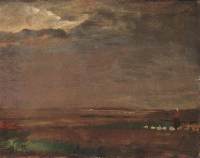
The art of Tornyai was only indirectly related to plein air although poorly interiors and landscapes of Szentendre painted at old age bathed in the glamour of rainbows. Landscapes of the Great Hungarian Plain in puritan simplicity and highly condensed genre-pictures on life in villages reflect Mihány Munkácsy's influence. Tornyai who came from a poor peasant family saw a bitter symbol of fate in the endless barren plain. He moved to a farm near Hódmezővásárhely, his native town, in 1907 for the first time where he painted the poorish vast plain from that time onwards which offered him few picturesque motifs only.
Like other painters, he considered it as a great challenge of how to portray the barren plain. "I love painting skies or plains, rather the soul than the appearance," he wrote. He concentrated mainly on colours of the sky covering most of his compositions. Dust and sand stirred up by wind often cover the country and mixtures of dirty colours dominate atmospheric changes in hundreds of his compositions. Autumn Morning features typical motifs of the plain, e.g. swing pole with a herd of cattle around or a goose-girl with white-feathered geese. In his later pictures he reduced the number of circles to fulfil his ars poetica, i.e. "real art ... is the manifestation of great passions and agitations in the simplest possible form". Thus, it was a deliberate choice to face the challenge of expressing the utmost with hardly any tools.